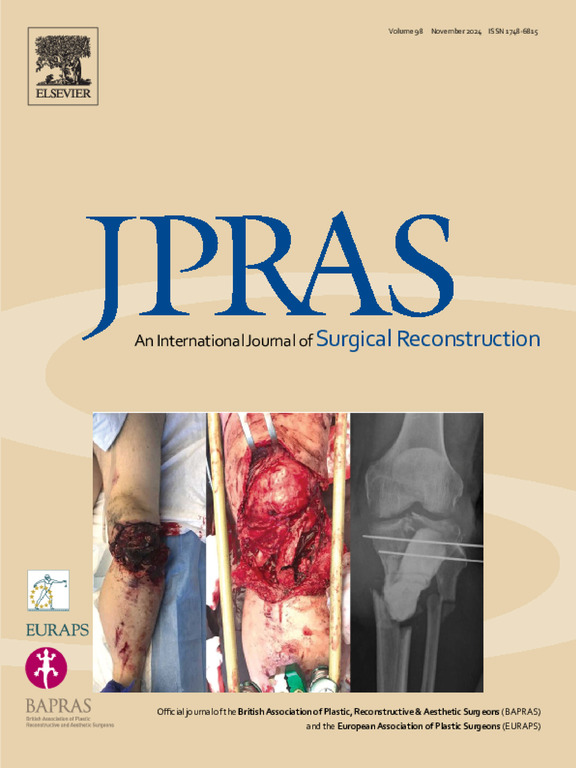美容整形患者心理健康状况及影响因素的横断面分析
IF 2.4
3区 医学
Q2 SURGERY
Journal of Plastic Reconstructive and Aesthetic Surgery
Pub Date : 2025-08-06
DOI:10.1016/j.bjps.2025.07.037
引用次数: 0
摘要
目的探讨美容整形患者的心理健康状况和身体形象相关困扰,并找出影响其心理健康和生活质量的关键人口学和临床因素。方法对某三级整形医院403例门诊和住院患者进行横断面调查。参与者完成了一份经过验证的五维心理评估量表,包括外貌担忧、情绪困扰、认知困扰、行为困扰和身体形象自卑。收集人口学和临床变量。采用t检验和方差分析进行独立组间比较。Spearman相关评估变量之间的关联,多元线性回归确定独立的预测因子。结果心理困扰总分平均为43.43±17.72分。子量表均值为:外表困扰(17.37±6.36)、情绪困扰(8.36±4.93)、认知困扰(7.13±4.68)、行为困扰(4.91±3.34)、身体形象自卑(4.89±3.03)。心理困扰因性别、年龄、收入和治疗频率而有显著差异(P <;0.05)。Spearman分析显示与性别(r = - 0.121)、教育程度(r = - 0.100)、收入(r = - 0.117)和治疗频率(r = 0.112-0.115)相关。回归发现男性性别、低收入和重复手术是加重痛苦的重要预测因素。结论美容手术患者的心理困扰受人口统计学和治疗相关因素的影响。男性患者、收入较低的患者和接受多次手术的个体表现出更大的脆弱性。这些发现强调了常规心理筛查和有针对性的干预措施对提高以患者为中心的护理和手术结果的重要性。本文章由计算机程序翻译,如有差异,请以英文原文为准。
Psychological health status and influencing factors among aesthetic plastic surgery patients: A cross-sectional analysis
Objective
This study explored psychological well-being and body image-related distress among patients undergoing aesthetic plastic surgery, and identified key demographic and clinical factors influencing their mental health and quality of life.
Methods
A cross-sectional survey was conducted among 403 outpatients and inpatients at a tertiary plastic surgery hospital. Participants completed a validated five-dimensional psychological assessment scale, comprising appearance concern, emotional distress, cognitive distress, behavioural distress, and body image inferiority. Demographic and clinical variables were collected. Independent group comparisons were performed using t-tests and ANOVA. Spearman’s correlation assessed associations between variables, and multiple linear regression identified independent predictors.
Results
The mean total psychological distress score was 43.43 ± 17.72. Subscale means were: appearance concern (17.37 ± 6.36), emotional distress (8.36 ± 4.93), cognitive distress (7.13 ± 4.68), behavioural distress (4.91 ± 3.34), and body image inferiority (4.89 ± 3.03). Psychological distress varied significantly by gender, age, income, and treatment frequency (P < 0.05). Spearman’s analysis indicated associations with gender (r = −0.121), education (r = −0.100), income (r = −0.117), and treatment frequency (r = 0.112–0.115). Regression identified male gender, low income, and repeated procedures as significant predictors of heightened distress.
Conclusion
Psychological distress among aesthetic surgery patients is shaped by demographic and treatment-related factors. Male patients, those with lower income, and individuals undergoing multiple procedures exhibit greater vulnerability. These findings underscore the importance of routine psychological screening and targeted interventions to enhance patient-centred care and surgical outcomes.
求助全文
通过发布文献求助,成功后即可免费获取论文全文。
去求助
来源期刊
CiteScore
3.10
自引率
11.10%
发文量
578
审稿时长
3.5 months
期刊介绍:
JPRAS An International Journal of Surgical Reconstruction is one of the world''s leading international journals, covering all the reconstructive and aesthetic aspects of plastic surgery.
The journal presents the latest surgical procedures with audit and outcome studies of new and established techniques in plastic surgery including: cleft lip and palate and other heads and neck surgery, hand surgery, lower limb trauma, burns, skin cancer, breast surgery and aesthetic surgery.

 求助内容:
求助内容: 应助结果提醒方式:
应助结果提醒方式:


